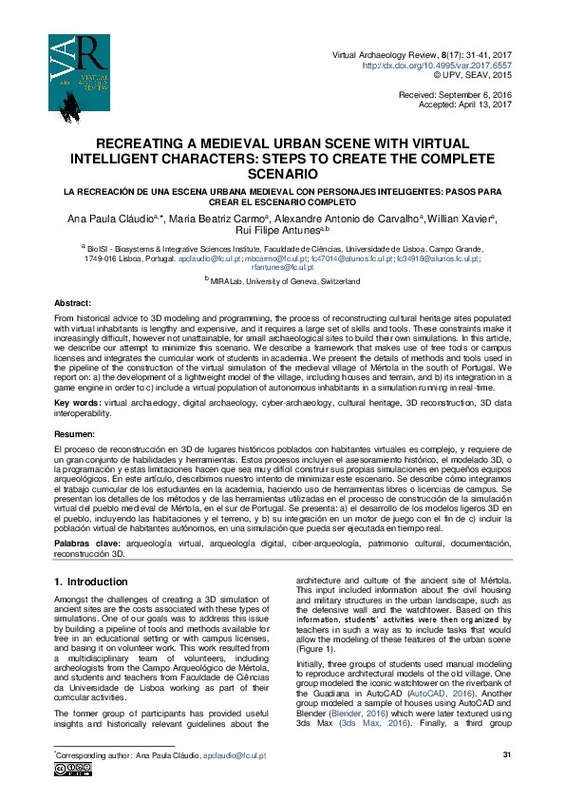JavaScript is disabled for your browser. Some features of this site may not work without it.
Buscar en RiuNet
Listar
Mi cuenta
Estadísticas
Ayuda RiuNet
Admin. UPV
Recreating a medieval urban scene with virtual intelligent characters: steps to create the complete scenario
Mostrar el registro sencillo del ítem
Ficheros en el ítem
| dc.contributor.author | Cláudio, Ana Paula
|
es_ES |
| dc.contributor.author | Carmo, Maria Beatriz
|
es_ES |
| dc.contributor.author | de Carvalho, Alexandre Antonio
|
es_ES |
| dc.contributor.author | Xavier, Willian
|
es_ES |
| dc.contributor.author | Antunes, Rui Filipe
|
es_ES |
| dc.date.accessioned | 2017-10-27T07:03:57Z | |
| dc.date.available | 2017-10-27T07:03:57Z | |
| dc.date.issued | 2017-07-26 | |
| dc.identifier.uri | http://hdl.handle.net/10251/90129 | |
| dc.description.abstract | [EN] From historical advice to 3D modeling and programming, the process of reconstructing cultural heritage sites populated with virtual inhabitants is lengthy and expensive, and it requires a large set of skills and tools. These constraints make it increasingly difficult, however not unattainable, for small archaeological sites to build their own simulations. In this article, we describe our attempt to minimize this scenario. We describe a framework that makes use of free tools or campus licenses and integrates the curricular work of students in academia. We present the details of methods and tools used in the pipeline of the construction of the virtual simulation of the medieval village of Mértola in the south of Portugal. We report on: a) the development of a lightweight model of the village, including houses and terrain, and b) its integration in a game engine in order to c) include a virtual population of autonomous inhabitants in a simulation running in real-time. | es_ES |
| dc.description.abstract | [ES] El proceso de reconstrucción en 3D de lugareshistóricospoblados con habitantes virtuales es complejo, y requiere de un gran conjunto de habilidades y herramientas. Estos procesos incluyen elasesoramiento histórico, el modelado 3D, ola programación y estas limitaciones hacen que sea muy difícil construir sus propias simulacionesenpequeños equipos arqueológicos. En este artículo, describimos nuestro intento de minimizar este escenario. Se describe cómo integramos el trabajo curricular de los estudiantes en la academia, haciendouso de herramientas libres olicencias de campus. Se presentan los detalles de los métodos y de las herramientas utilizadas en el processo de construcción de la simulación virtual del pueblo medieval de Mértola, en el sur de Portugal. Se presenta: a)el desarrollo de los modelos ligeros 3D en el pueblo, incluyendo las habitaciones y el terreno, yb) su integración en unmotor de juego con el fin de c)incluir la población virtual de habitantes autónomos, en una simulación que pueda ser ejecutadaen tiempo real. | es_ES |
| dc.description.sponsorship | This project was funded by the Horizon 2020: EU Framework Programme for Research and Innovation under Marie Skłodowska-Curie grant agreement No. 655226 (fellowship to Dr. Rui Filipe Antunes). We knowledge the support of BioISI R&D unit (UID/MULTI/04046/2013), Portugal, the information provided by the team of Campo Arqueológico de Mértola and the students that produced the models and scenarios. Proofreading by Piki Productions. | |
| dc.language | Inglés | es_ES |
| dc.publisher | Universitat Politècnica de València | |
| dc.relation.ispartof | Virtual Archaeology Review | |
| dc.rights | Reconocimiento - No comercial - Sin obra derivada (by-nc-nd) | es_ES |
| dc.subject | Virtual archaeology | es_ES |
| dc.subject | Digital archaeology | es_ES |
| dc.subject | Cyber archaeology | es_ES |
| dc.subject | Cultural heritage | es_ES |
| dc.subject | 3D reconstruction | es_ES |
| dc.subject | 3D data interoperability | es_ES |
| dc.subject | Arqueología virtual | es_ES |
| dc.subject | Arqueología digital | es_ES |
| dc.subject | Ciber arqueología | es_ES |
| dc.subject | Patrimonio cultural | es_ES |
| dc.subject | Documentación | es_ES |
| dc.subject | Reconstrucción 3D | es_ES |
| dc.title | Recreating a medieval urban scene with virtual intelligent characters: steps to create the complete scenario | es_ES |
| dc.title.alternative | La recreación de una escena urbana medieval con personajes inteligentes: pasos para crear el escenario completo | es_ES |
| dc.type | Artículo | es_ES |
| dc.date.updated | 2017-10-27T06:32:08Z | |
| dc.identifier.doi | 10.4995/var.2017.6557 | |
| dc.relation.projectID | info:eu-repo/grantAgreement/EC/H2020/655226/EU/BIHC- Bio-inspired models of human crowds/ | es_ES |
| dc.relation.projectID | info:eu-repo/grantAgreement/ULISBOA//UID%2FMULTI%2F04046%2F2013/ | es_ES |
| dc.rights.accessRights | Abierto | es_ES |
| dc.description.bibliographicCitation | Cláudio, AP.; Carmo, MB.; De Carvalho, AA.; Xavier, W.; Antunes, RF. (2017). Recreating a medieval urban scene with virtual intelligent characters: steps to create the complete scenario. Virtual Archaeology Review. 8(17):31-41. https://doi.org/10.4995/var.2017.6557 | es_ES |
| dc.description.accrualMethod | SWORD | es_ES |
| dc.relation.publisherversion | https://doi.org/10.4995/var.2017.6557 | es_ES |
| dc.description.upvformatpinicio | 31 | es_ES |
| dc.description.upvformatpfin | 41 | es_ES |
| dc.type.version | info:eu-repo/semantics/publishedVersion | es_ES |
| dc.description.volume | 8 | |
| dc.description.issue | 17 | |
| dc.identifier.eissn | 1989-9947 | |
| dc.contributor.funder | European Commission | |
| dc.contributor.funder | Universidade de Lisboa, Portugal |








